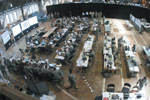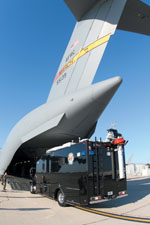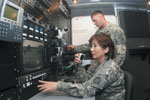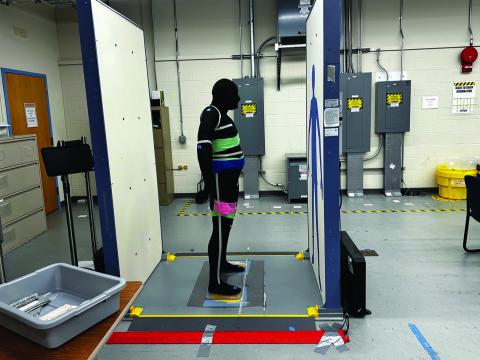Command Delivers Connectivity During Crises
 |
| One of U.S. Army North’s (ARNORTH’s) Sentinel operational command posts (OCPs) performs its mission while set up in a remote location in Providence, Rhode Island. The mission was part of exercise Ardent Sentry 2007, a Chairman, Joint Chiefs of Staff-directed, U.S. Northern Command-sponsored homeland defense and defense support of civil authorities event. |
The U.S. Army sector of U.S. Northern Command is contributing to homeland security and defense by bringing communications where and when it is needed most. To enhance its ability to keep leaders and first responders connected, U.S. Army North recently opened a new network operations center at its home base in
Col. Quill Ferguson, USA, G-6, U.S. Army North (ARNORTH), Fort Sam Houston, explains that the differences between the missions of soldiers defending the homeland and those fighting abroad delineate the communications requirements between the two. Although all communications equipment may appear equal to a casual observer, the specialized mission of ARNORTH personnel calls for connectivity well beyond military jointness. The organization must be ready and able to respond at a moment’s notice with capabilities that enable multiple levels of communications among federal, state and local personnel by bridging the gap of both equipment and rank. Standard program-of-record items often cannot fulfill this need, Col. Ferguson points out.
Initially, the U.S. Department of Homeland Security (DHS) outlined 13 national planning scenarios that call for emergency assistance; last year, ARNORTH trimmed this number to the eight they are most likely to support. The command’s focus is now on explosives, nuclear, radiological, biological, chemical or cyberattacks; natural disasters; and pandemic influenza.
Although ARNORTH provides command and control capabilities, it supports—not commands—responses in a homeland emergency, the colonel emphasizes. “Defense Department Title X has a lot of capabilities that the states don’t have, so sometimes we’re the only ones who can do that mission. But for the most part, the mantra is that we are there to support; we’re not in charge,” he emphasizes.
How ARNORTH reacts to an emergency is an indication of its mission to support. When an emergency occurs, the state’s governor calls on state assets first. States also have entered into cross-state agreements—called emergency management assistance compacts—that facilitate cooperation when a situation crosses borders. When these resources are insufficient, the governor requests assistance from DHS through the president. If approved, the Federal Emergency Management Agency (FEMA) and U.S. Defense Department are called on for assistance. Col. Ferguson notes that federal assistance is not guaranteed; rather, it depends on perceived capabilities gaps. For example, in spring 2008, California Governor Arnold Schwarzenegger’s request for assistance to fight wildfires was denied.
Once the decision to provide support is made, the request is filtered through DHS to the appropriate organization or contractor. If the Defense Department is called on to assist, the request proceeds through U.S. Northern Command (NORTHCOM), at which point ARNORTH may be enlisted to respond.
ARNORTH’s 10 regional defense coordinating officers are the organization’s tip of the spear. “They’re co-located as close as we could get them to the 10 FEMA regions. They are the day-to-day engagement entity of both NORTHCOM and ARNORTH. They do the full sphere of engagement,” Col. Ferguson explains.
The command already has taken on a variety of missions since its inception in October 2006. Among its support to civil authorities’ missions, ARNORTH counts assistance during the I-35 bridge collapse in
This tip-of-the-spear role is particularly apparent in the devices and equipment-laden vehicles the command controls, maintains and sends out. A SWE-DISH system, which features a Ku-band satellite terminal, enables the team to access the Internet and is used during the initial entry phase of a mission. Weighing 100 pounds, the system fits in two large cases manufactured by Pelican Products Incorporated and can be set up in approximately 10 minutes. Data transfer speeds run at 1-megabit-per-second uploads and 2-megabit-per-second downloads, and the system includes 10 voice over Internet protocol (VoIP) telephone connections and one switch.
Using this fly-away kit, the ARNORTH response team can establish a virtual private network (VPN) that enables it to access the military network. According to Jeff Chase, network manager, Operational Command Post 2, once the VPN is established, “it is just like sitting at our desks at the office.”
In addition to the SWE-DISH system, ARNORTH owns a fleet of 19 emergency response vehicles (ERVs). Each vehicle features the same capabilities as the SWE-DISH system; however, when the network comes online, it automatically builds a VPN tunnel. “So when this vehicle comes up, it is an extension of the Fort Sam Houston network,” Chase explains.
Capabilities on this system also can be set up quickly. The time from arrival to an area to network and satellite connectivity is approximately 10 to 15 minutes. Connectivity can be extended to nearby buildings or other structures via 1,000 feet of fiber optic cable, he adds.
The ERVs include voice over IP (VoIP) telephones that have been set up through Fort Sam Houston, so, similar to the VPN with the fly-away system, using them is akin to dialing from a headquarters telephone.
Equipment inside each ERV resembles on-the-spot news television vans. A digital subscriber service television accessed through the satellite on a mast on the vehicle’s roof allows ERV personnel to view the basic package of channels available through satellite television providers.
 |
 |
| One of ARNORTH’s Sentinel vehicles (t) is offloaded from a C-17 Globemaster III at March Air Reserve Base, California, to support efforts during the Southern California wildfires. ARNORTH civilian employees (b) operate equipment in the Sentinel vehicle that enables them to monitor activity outside of the vehicle and facilitate communications between disparate communications equipment. |
ERVs also feature their own built-in computer system that acts as a packet server. Once a computer is plugged into the system, a user can pull down updated information that has been pushed out by Fort Sam Houston personnel. With a KG-250 high-assurance Internet protocol encryptor onboard, it is capable of classified communications.
In response to the 9/11 Commission’s identification of the lack of radio interoperability between first responders, ARNORTH acquired equipment that ensures the problem is less likely to occur again. Systems within the ERV allow ARNORTH’s team to take radios operating on different frequencies and patch them together. “So if you’re on an 800-megahertz radio and the fire department is on a VHF [very high frequency] radio, I can tie those two together in the software in the radio, and it will retransmit yours so you and the firefighters can communicate back and forth,” Chase explains. A frequency manager conducts spectrum coordination either prior to entering an area or on the fly to ensure communications, he adds.
The ERV also houses four cellular modems so that if the team finds itself in an area where it cannot raise the antenna, it can still communicate using cell phones, assuming cell service in the area still exists. “A lot of thought went into the backup of systems,” Chase says.
All of the equipment in the ERV is commercially available, and even the vehicle itself is “off the lot.” It is a standard Chevy 2500 series Suburban gutted to add the equipment and only modified with an additional spring in back and a generator under the hood.
Many of the communications features that the ERVs sport also are contained in two other types of communications vehicles ARNORTH owns to support emergency operations: the Super Sentinel and the Sentinel. These communication wonders on wheels look alike but are different in overall capability, notes Kyle Monsees, network manager, Operational Command Post 1, ARNORTH. While the former is similar to the ERV, the latter is a primary platform for communications as an operational command post (OCP).
Each of the two Super Sentinels the command owns is an extension of the ARNORTH network at Fort Sam Houston. Each provides a reach-back capability and workspace for up to 15 people who can conduct secure and nonsecure networking in two videoconferencing suites. The vehicle features operator stations where personnel can monitor satellite-receiving capabilities, information video systems and radios. Workstations are located in the front and back of the Super Sentinel, and personnel can choose what they view on two flat-panel televisions.
Video, voice, data and videoconferencing all take place over IP. Secure terminal equipment enables users to work in a secure environment. “Eventually, we will have the capability to do secure over IP. The technology is out there, we just didn’t purchase the devices,” Monsees says. Prohibitive cost was one reason the devices were not purchased, he adds.
ARNORTH owns two Sentinel vehicles. They are a deployable communications package that provides communications support to ARNORTH’s OCP. Personnel in the command post work with civilian first responders deployed to an incident site, such as hurricane relief, riots, hazardous material spills and terrorist attacks. Incident teams comprise representatives from organizations including NORTHCOM,
Like the Super Sentinel, the vehicles are built on truck frames that L-3 Wolf Coach fills with a full suite of networking capabilities. “Other vehicles can give you [the nonsecure Internet protocol router network] and [the secret Internet protocol router network] and so on, but they are an extension of the Fort Sam Houston network. This vehicle is a stand-alone communications platform, and it is fully compatible with radios and frequencies that they use,” Monsees explains. By combining a Sentinel’s capabilities with other Army communications assets, ARNORTH personnel can communicate not only with first responders on the ground but also with the military, he adds.
The vehicle can support up to 55 unclassified and 30 unclassified computer users as well as 40 VoIP and 22 analog telephones simultaneously; all the computers are inherent to the vehicle. Because the Sentinel generates the power it needs for the equipment inside, it can be deployed to austere environments to provide network services.
The operators section in the Sentinel has monitors that can display television programs in the local area and two direct satellite television stations, live streaming video from the 40-foot pneumatic mast camera and an array of small cameras mounted on the exterior of the vehicle, video onboard DVD player and videoconferencing. The onboard DVD player can record video captured from the camera located on the mast. Three video servers—each with its own IP address—allow military installation personnel to view what the Sentinel is broadcasting on the mast camera, the DVD player and one of the television monitors in the Sentinel.
Segovia Incorporated provides on-demand Internet service for ARNORTH. Monsees explains that the Army contracted with the company so that the command does not have to request satellite access, wait for authorization, then reconfigure its devices every time the vehicles are called to duty. Instead, the Sentinels have their own specific IP addresses, so when the crew turns on the equipment to connect, the company sees it on its network and its satellites.
The DVD player in the vehicle has an internal 160-gigabyte hard drive that allows personnel to record video from one of the onboard monitors. “So if we weren’t up on the satellite, we could take the camera and, through controls within the vehicle, move it around, zoom in and start recording,” Monsees explains. “We can then take this playback and, at any time, have it streamed on one of our video web servers for our headquarters personnel to view.”
Like the ERVs, the Sentinel can facilitate communications between personnel operating on different frequencies. With a couple clicks of the mouse, computer software enables cross-band communications. Sentinel personnel can enable police on the ground to speak with military personnel in aircraft, for example, even though one is in the 800-megahertz frequency and the other in the VHF range, Monsees notes. For secured communications, personnel must switch over to military communications, he adds.
A Sentinel’s networking environment includes six cellular base stations: two global system for mobile communications, or GSM, and four code division multiple access, or CDMA. Both were installed on the vehicle because mobile communications in various areas of the country use different standards. Using one of the VoIP telephones in the vehicle, team members can place a call in three ways: over IP, using cell service or via satellite.
The networking environment features two network stacks, one classified and one unclassified. Each stack has two physical servers that run six virtual servers. A VPN tunnel is created from wherever the vehicle is located to Fort Sam Houston; this maintains military integrity. The unclassified hard drives feature 1 terabyte of storage, while the classified hard drives feature 3 terabytes of storage. ARNORTH is upgrading the unclassified stack so it too will have 3 terabytes of storage.
“Originally, we planned for all the extra servers to be here, and they’d all be on. But as the technology and capabilities came out, we cut all of these back to two physical servers on each side, but we actually run up to seven servers. Within this array of discs, we have all of our seven servers built virtually, and they’re also backed up along here, too. If we lose a hard drive, it’s backed up with the rest of them. They’re all running in here in a virtual environment through software. That provides us our top-level network, user domain authentication, domain network, file server, print server and e-mail server. No matter where the person is, someone can e-mail to one address, and it always comes to the vehicle,” Monsees explains. The servers’ hard drives are hot-swappable, he adds, so if one goes bad, it can be replaced on the fly without losing network integrity.
To meet Army and Defense Department standards for Federal Information Processing Standard (FIPS) 140-2, the OCP runs a wireless network; this also facilitates set-up. “We run the fiber cable reel, put one of the outriggers on the floor, and in it is one of our wireless access points. When computers are turned on, they connect to our access point; specific software must be installed for this to occur. DOD requires a FIPS 140-2-certified encryption. If you don’t have the software or the encryption key on your computer, then you’re not hitting our network at all; it won’t even give you an IP address,” Monsees notes.
The Sentinel is generally staffed by 11 people to cover 24-hour operations; many are cross-trained so they can step into each other’s jobs if necessary.
All of this technology is more necessary than ever as ARNORTH’s missions continue to be refined. Col. Ferguson explains that in addition to being the Joint Force Land Component Command and Army Service Component Command to NORTHCOM for homeland defense, civil support operations such as Joint Task Force–Civil Support and theater security cooperation activities, the command recently became the Joint Task Force–North (JTF-North), which operates out of
Another responsibility recently added to ARNORTH’s strategic objectives is to anticipate—not just respond to—emergencies. The colonel points out that this is a double-edged sword. “When you anticipate, you’re injecting resources into the equation that first haven’t been formally requested and second haven’t been funded. Leaning forward without authority could mean the Department of the Army versus FEMA or whoever was asked for resources has to come up with funds to pay that bill,” he notes.
“But ‘anticipate’ is very important to us because as C4 [command, control, communications and computers] providers it means get ready to go now. It does create some issues for us—mainly the two that I just mentioned—but the American people do not want to hear that there was not an MA [mission area] request for assistance and we didn’t go because we weren’t ready. It’s like having the capability sitting, and CNN is there looking at the capability, but people are starving or dying. I bring that up because that’s pretty big for us right now, and we’re trying to figure out how we deal with that without going bankrupt,” he states.
Web Resources
Defense Coordinating Officer regions: www.arnorth.army.mil/DCO/default.htm
L-3 Wolf Coach: www.l-3com.com/WolfCoach
Segovia Incorporated: www.segoviaip.com
Army North Leader Guides Evolutionary Progress Lt. Gen. Thomas R. Turner, “Each new mission comes with a different challenge,” Gen. Turner says. “No place is this more vivid than in the signal world. First of all, you start working with government agencies the way the Army commands and controls, and then you throw in the joint piece.” The commercial equipment the command purchased that enables its staff to communicate with first responders as well as personnel at combatant command U.S. North Command “was really money well spent,” he adds. The ability for the defense coordinating officers (DCOs) to interface with the people they need to regardless of service or organization, as well as their mental agility, has stood the command in great stead, he states. In some instances, because of the increased situational understanding, the DCOs’ nimbleness—complemented by communications capabilities—has allowed ARNORTH to commit fewer forces to assist in a crisis, the general notes. Every new mission also reveals new requirements, Gen. Turner shares. “As we begin to put together this consequence management response force, and we bring together three brigades—one brigade combat team, one combat aviation brigade and one medical brigade, all with recent Iraqi experience—under JTF-CS [Joint Task Force–Civil Support], they come with a lot of X type of equipment. All Army brigades have become comfortable with the Command Post of the Future over there, so we have a whole new community to link together now to allow civil support to command and control these Army brigades,” he notes. The general says his principal challenge is ensuring that ARNORTH has a unified effort should it need to respond for consequence management in a chemical, biological, radiological or nuclear explosion event. Although local and state capabilities to handle such an event are increasing, it is likely they would not be enough. “If you look at the national planning scenarios, there are several that are so catastrophic that it would be obvious that they would want some of the Defense Department capability. So ensuring that the capability exists, is responsive and can do what we will need for the lead federal agency or the state and local officials are the issues that we probably spend most of our time on lately,” Gen. Turner states. One capability that would assist in this challenge is the ability to view a common operational picture and same situational understanding when the need arises, the general points out. But beyond the capabilities, one of the primary requirements are the processes that will help integrate different organizations, he adds. “The bottom line is that .mil and .gov are two different entities, and they occasionally cause us information-sharing problems. Being able to have access to what I want to access on the Army network and still be able to communicate on the joint network with one boss is pretty important to me, and that seems to be pretty difficult,” he says. |




Comments